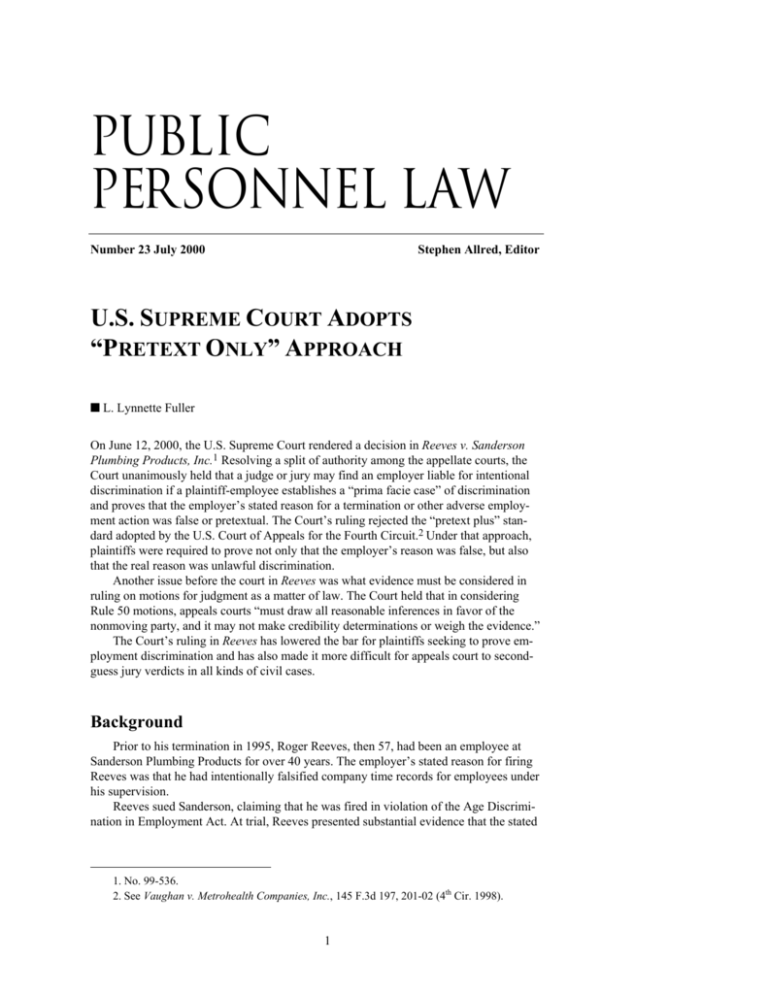Public Personnel Law - The University of North Carolina at Chapel Hill
advertisement

Public Personnel Law Number 23 July 2000 Stephen Allred, Editor U.S. SUPREME COURT ADOPTS “PRETEXT ONLY” APPROACH ■ L. Lynnette Fuller On June 12, 2000, the U.S. Supreme Court rendered a decision in Reeves v. Sanderson Plumbing Products, Inc.1 Resolving a split of authority among the appellate courts, the Court unanimously held that a judge or jury may find an employer liable for intentional discrimination if a plaintiff-employee establishes a “prima facie case” of discrimination and proves that the employer’s stated reason for a termination or other adverse employment action was false or pretextual. The Court’s ruling rejected the “pretext plus” standard adopted by the U.S. Court of Appeals for the Fourth Circuit.2 Under that approach, plaintiffs were required to prove not only that the employer’s reason was false, but also that the real reason was unlawful discrimination. Another issue before the court in Reeves was what evidence must be considered in ruling on motions for judgment as a matter of law. The Court held that in considering Rule 50 motions, appeals courts “must draw all reasonable inferences in favor of the nonmoving party, and it may not make credibility determinations or weigh the evidence.” The Court’s ruling in Reeves has lowered the bar for plaintiffs seeking to prove employment discrimination and has also made it more difficult for appeals court to secondguess jury verdicts in all kinds of civil cases. Background Prior to his termination in 1995, Roger Reeves, then 57, had been an employee at Sanderson Plumbing Products for over 40 years. The employer’s stated reason for firing Reeves was that he had intentionally falsified company time records for employees under his supervision. Reeves sued Sanderson, claiming that he was fired in violation of the Age Discrimination in Employment Act. At trial, Reeves presented substantial evidence that the stated 1. No. 99-536. 2. See Vaughan v. Metrohealth Companies, Inc., 145 F.3d 197, 201-02 (4th Cir. 1998). 1 Public Personnel Law Bulletin No. 23 July 2000 reason for his discharge was false. He also presented testimony that the manager who recommended his termination had subjected him to verbal abuse on account of his age. The manager told Reeves he “was so old [he] must have come over on the Mayflower” and, on another occasion, that he “was too damn old to do [his] job.” Reeves also established that after his termination, Sanderson had used three different replacements for him, all of whom were under 40. The jury found Sanderson liable for willful age discrimination and awarded Reeves nearly $100,000 in damages. However, the Fifth Circuit Court of Appeals reversed the decision and entered judgment for Sanderson as a matter of law, holding that Reeves had not introduced sufficient evidence to sustain the jury’s finding of unlawful discrimination. The Fifth Circuit said that although Reeves may have presented sufficient evidence to show that the company’s reason for firing him was pretextual, he had not established that age discrimination was its true motive. The court found that the age-related comments by Reeve’s manager were not made in the context of his termination; that the persons making the decision to fire Reeves were themselves over age 50; and that several of the company’s management positions were filled by persons over age 50. Reeves appealed to the U.S. Supreme Court and it agreed to decide what an employee must show in order to avoid summary judgment and take an employment discrimination case to the jury. The Fifth Circuit, as did the First, Second and the Fourth took the “pretext plus” position whereby the plaintiff was required to prove that the employer’s proffered reason for the adverse decision was false and that discrimination was the real reason. The Third, Sixth and Eleventh circuits used a “pretext only” standard which held that the employee only had to produce a prima facie case of discrimination and establish that the employer’s stated explanation was false. ployer still had an unstated, but legitimate reason. At the same time, the Court said in Hicks that rejection of the reason offered by the employer permits the trier of fact to infer intentional discrimination without additional proof. In an attempt to clarify its earlier ruling, O’Connor wrote “it is permissible for the trier of fact to infer the ultimate fact of discrimination from the falsity of the employer’s explanation.” The Court also said, “In appropriate circumstances, the trier of fact can reasonably infer from the falsity of the explanation that the employer is dissembling to cover up a discriminatory purpose.” Thus, a plaintiff’s prima facie case, combined with evidence that the employer’s proffered reason for the adverse employment decision is false, may permit the judge or jury to find unlawful discrimination. But the court cautioned that such a showing by the plaintiff will not always be sufficient for a jury to find liability. There could be instances where, although the plaintiff has established a prima facie case and introduced evidence to reject the employer’s explanation, no rational factfinder could conclude that discrimination had occurred. For example, there could be some other, nondiscriminatory reason for the employer’s decision. Similarly, the employer may be entitled to judgment as a matter of law if the plaintiff created only a weak issue of fact as to whether the employer’s stated reason was untrue and there was ample evidence that no discrimination occurred. Turning to the question of whether Sanderson was entitled to judgment as a matter of law, the Court noted that Rule 50 requires a court to render judgment as a matter of law when a party has been fully heard on an issue, and there is no legally sufficient evidentiary basis for a reasonable jury to find for that party on that issue. The court must review all of the evidence in the record, drawing all reasonable inferences in favor of the nonmoving party, and it may not make credibility determinations or weigh the evidence. In this case, the Court held that the Fifth Circuit misapplied the Rule 50 standard of review in disregarding evidence favorable to Reeves and failing to draw all reasonable inferences in his favor. As an example, the Court cited the fact that the Fifth Circuit acknowledged the age-related comments by Reeves’ manager but discounted them on the ground that they were not made in the direct context of the firing. The Court held that since Reeves had established a prima facie case, introduced enough evidence for the jury to reject the employer’s explanation, and produced additional evidence that his manager was motivated by age-based animus, there was sufficient evidence for The Supreme Court Ruling Writing for the Supreme Court, Justice Sandra Day O’Connor said that the Fifth Circuit “misconceived” the evidentiary burden on plaintiffs trying to prove intentional discrimination with indirect evidence. The Court revisited its 1993 ruling in St. Mary’s Honor Center v. Hicks3 which held that proving pretext does not compel judgment for the employee because there is a possibility that the em3. 509 U.S. 502, 113 S.Ct. 2742, 125 L.Ed.2d 407 (1993). 2 July 2000 Public Personnel Law Bulletin No. 23 employment decision. An attempt to spare an employee’s feelings could later be used as evidence of discrimination. For example, suppose that an employer tells the employee that the reason for his or her discharge is that the position is being eliminated when the true reason is that the employee is performing poorly. Assuming that the employee is a member of a protected class and could establish a prima facie case of discrimination, evidence that the employer’s proffered reason for the termination is false could be used to allow the trier of fact to infer unlawful discrimination. Of course, the employee would need to have some further support for his or her allegations of discrimination. Employers should assure themselves that the rationale for a decision is credible and consistent with other actions taken in the past based on similar circumstances. As always, documentation of decisions and performance problems is critical, as are wellcommunicated anti-discrimination policies. the jury to conclude that Sanderson had intentionally discriminated against Reeves and that Sanderson was not entitled to judgment as a matter of law. Implications for North Carolina Public Employers This opinion resolves a split in the federal appellate courts and in so doing, overrules a Fourth Circuit approach that favored employers. As a result of this decision, proving employment discrimination just became a little easier. Although Reeves involved age discrimination, it is likely that the “pretext only” standard adopted by the Court will apply in other employment discrimination cases as well. Assuming this is the case, it will be more difficult for employers to dispense with these cases on summary judgment motions. Consequently, employers should expect more jury trials and increased pressure for settlement. In light of the holding, employers would be well advised not to “sugarcoat” the reasons for an adverse This Bulletin is published by the Institute of Government to address issues of interest to local and state government employees and officials. Public officials may photocopy the Bulletin under the following conditions: (1) it is copied in its entirety; (2) it is copied solely for distribution to other public officials, employees, or staff members; and (3) copies are not sold or used for commercial purposes. Additional copies of this Bulletin may be purchased from the Institute of Government. To place an order or to request a catalog of Institute of Government publications, please contact the Publications Sales Office, Institute of Government, CB# 3330 Knapp Building, UNC-CH, Chapel Hill, NC 27599-3330; telephone (919) 966-4119; fax (919) 962-2707; e-mail khunt@iogmail.iog.unc.edu; or visit the Institute’s web site at http://ncinfo.iog.unc.edu. ©2000 Institute of Government. The University of North Carolina at Chapel Hill Printed in the United States of America This publication is printed on permanent, acid-free paper in compliance with the North Carolina General Statutes 3






